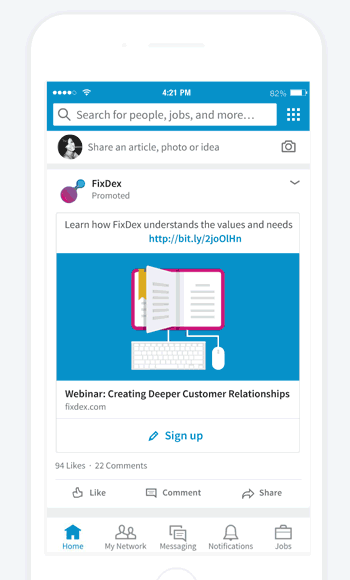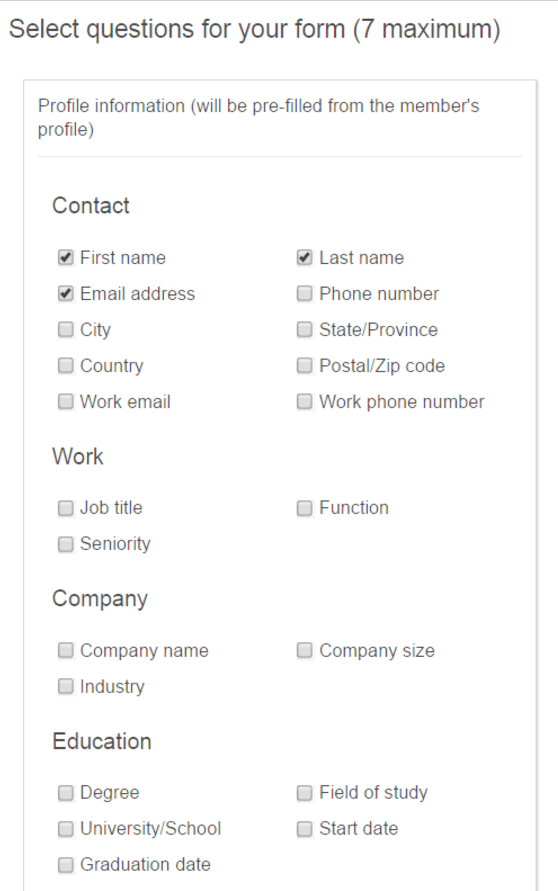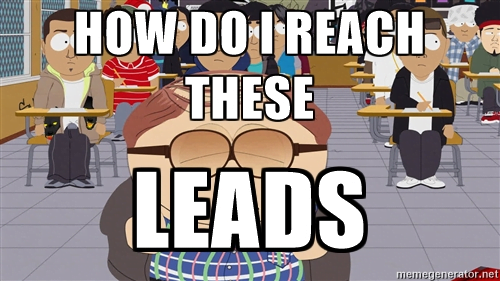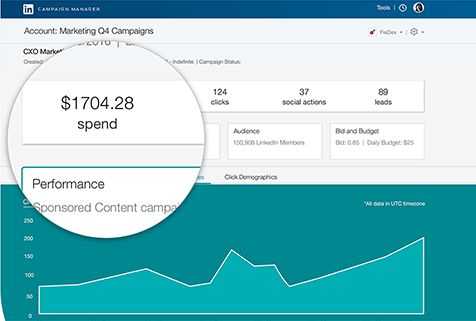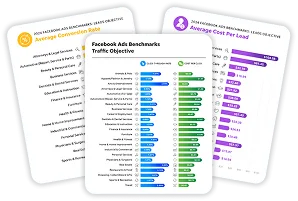
Late last year I wrote a blog post on the 5 questions advertisers should ask themselves each quarter.
In it, I suggested seeking opportunities on new networks. Facebook and Bing? No brainers. Twitter? Eh. But LinkedIn? My feelings were, uh, strong…
A certain unicorn-hunting Thought Leader™ might have had similar feelings…
Well, today the fourth item can be crossed off Larry’s list.
Today, I come to you a changed man, a man convinced that symphonic arthropods aren’t all Reid Hoffman and Co. have going for them (ad-wise, at least).
Why the change of heart?
What’s a LinkedIn Lead Gen Form?
Per LinkedIn, Lead Gen Forms are “a new solution that helps you drive even more high-quality leads from your Sponsored Content campaigns by removing the main barrier to mobile conversion: making someone complete a clunky contact form on a smartphone.”
Per me, they might be LinkedIn’s route to viability as an ad platform.
Prior to, oh, about yesterday, LinkedIn sponsored content was clunky and overpriced, making it damn near impossible to leverage the social network’s robust business-centric targeting. It sucked.
Today? Less so.
These new lead ads are a push towards capturing valuable information from almost half a billion potential prospects on the devices they use most: their phones. LinkedIn has removed two major barriers to conversion that businesses advertising on mobile devices face:
- Mobile landing page experience
- Completing a form using nothing but thumbs
Now, when a targeted LinkedIn user clicks the new “Sign up” button on a piece of your sponsored content, they’re brought to a (mostly) pre-populated lead form. LinkedIn pulls pertinent data right from a prospect’s probably-up-to-date personal page, ensuring accurate contact information. From there, you can either share content with a prospect (now a bona fide lead) or direct them to your website.
No typographic errors attributable to meaty digits. No dummy demo accounts. No Eastern European spam bots. Just leads, baby.
Over on Facebook, many advertisers have already found success using lead ads; it stands to reason that LinkedIn’s Lead Gen Forms will be a boon for advertisers, too. Let’s take a closer look at some of the key factors in determining whether LinkedIn Lead Gen Forms are right for your business.
LinkedIn Lead Gen Form UX
The general look and feel of LinkedIn’s lead ads is very much comparable to their Facebook equivalent. From a prospect’s perspective, the ad flows seamlessly from your piece of sponsored content to a mostly pre-populated form and then to a thank you page.
The fact that so much pertinent lead information can be pulled directly from LinkedIn profile pages makes the experience seamless for prospects. Lead gen forms cannot exceed seven questions, so even if there’s information a prospect needs to input manually, doing so isn’t as cumbersome as it could be.
It’s also worth mentioning that prospects can edit pre-populated contact information (email address and phone number) if those pulled from their LinkedIn profile are no longer valid.
How does it compare to Facebook Lead Ads?
At first glance, LinkedIn Lead Gen Forms have two steps fewer than Facebook lead ads.
The lack of a terms and conditions page makes LinkedIn Lead Gen Forms a bit quicker to complete, but the difference seems negligible. Finally, the autocompletion of key contact information, shared by both platforms, makes conversion easier on a mobile device.
LinkedIn Lead Gen Form ROI
TBD… for now.
We haven’t run them yet, but per LinkedIn, “Ninety percent of the 50 customers surveyed from our pilot beat their cost-per-lead (CPL) goals. They also saw lower CPLs with Lead Gen Forms compared to their standard Sponsored Content campaigns.”
Now, this statement makes it seem as though lead gen forms are exceptionally effective. In reality, they’re probably not quite as good as LinkedIn is touting (yet). Based on my limited experience, standard Sponsored Content has not proven particularly effective; beating CPL goals associated with the format is nothing to slouch at, but improving upon something mediocre doesn’t necessarily mean extraordinary value or results. Try ‘em out, but tread lightly.
How does it compare to Facebook Lead Ads?
Lead gen forms on Facebook are a mixed bag and largely depend on your vertical and the targeting methods you’re using. I’ve seen accounts that attempt to use lead ads at the top of the funnel and they bring in a ton of unqualified leads. This gets expensive real quick.
Conversely, as a mid-funnel and pre-close tool (used in a remarketing campaign to encourage a nurtured lead to book a demo) Facebook lead ads are straight fire. I imagine LinkedIn will function similarly; that being said, since there are probably less spam accounts on LinkedIn than Facebook, and the targeting options all but ensure some semblance of professional interest, Lead Gen Forms could have a bigger impact on top of funnel campaigns.
LinkedIn Lead Gen Form Lead Quality
Here’s where I think LinkedIn Lead Gen Forms will make their mark.
LinkedIn is unique among social networks in that advertisers can leverage mounds of professional data that’s (usually) up to date. The profile stewardship exhibited by most members ensure that the lead data captured by advertisers is up-to-date (much less likely to be a fake email address or phone number), creating better informed, easier-to-convert sales opportunities.
How does it compare to Facebook Lead Ads?
Facebook is valuable to advertisers because everyone and their mother uses it.
LinkedIn’s user base is much smaller than Facebook’s (just under half a billion), but now that lead gen forms are available to advertisers, their cost combined with the amount of profession-based targeting information available should make it the perfect channel for B2B marketers.
LinkedIn Lead Gen Form Measurability
The two most important KPIs you can track within the LinkedIn UI are CPL and form fill rate. And since there’s no need for a prospect to visit your website on their path to conversion, there’s no need for any kind of tricky tracking code implementation on your part.
Per LinkedIn, the internal reporting tools allow advertisers to “track key metrics like CPL, form fill rate, and other important data points to measure the value you’re getting from your ad spend. In the near future, we’ll also include demographic reports that show the exact number of leads you’re getting from specific audience segments.”
That last part gets me especially excited, since this demographic information has the potential to improve performance on other channels, too.
How does it compare to Facebook Lead Ads?
LinkedIn and Facebook both have a lot to learn from Google when it comes to measurability. While both platforms have made strides of late and they both offer more robust targeting options than AdWords, the extent to which you can measure things like attribution and other advanced metrics still lags behind.
LinkedIn Lead Gen Form Manageability
Per LinkedIn, Lead Gen Forms are already compatible with Zapier and Driftrock. If you use either of these systems for marketing automation, LinkedIn leads will pull into your existing CRM in real-time.
There are plans to offer integrations with Marketo, Microsoft Dynamic 3654, and Oracle Eloqua, too. Stay tuned.
How does it compare to Facebook Lead Ads?
Just like Facebook, if you use a non-compatible CRM and don’t have a team of developers who can work with the LinkedIn API, you can still harvest magical, delicious, top-shelf leads. All you need to do is download the CSV file containing your lead. Just don’t forget to check in frequently; doing so would allow those scorching hot prospects to cool off or worse, stumble upon your competitors.
Also worth noting: LinkedIn’s launch article alludes to their giving advertisers the ability to include Lead Gen Forms in sponsored InMail campaigns for both mobile and desktop later this year. This should take another step towards relevance for B2B marketers.
Learn more about making the most of LinkedIn lead gen ads.

